Multi-Objective Optimization of Novel Aluminum Welding Fillers Reinforced with Niobium Diboride Nanoparticles
Abstract
1. Introduction
2. Materials and Methods
2.1. Optimization Process
2.2. Filler Manufacturing
2.2.1. Step 1—Synthesis of NbB2 Pellets
2.2.2. Step 2—Stir Casting
2.2.3. Step 3—Quality Test
3. Results
3.1. Response Variable Analysis: Brinell Hardness
Equation (1): Regression Equation of Brinell Hardness
3.2. Response Variable Analysis: Porosity
Equation (2): Regression Equation of Porosity
3.3. Optimal Multi-Objective Optimization Solution for Brinell Hardness and Porosity
4. Discussion
4.1. Central Composite Design Analysis: Brinell Hardness
4.2. Central Composite Design Analysis: Porosity
5. Conclusions
- The analysis of variance (ANOVA) conducted for the transformed response for hardness reveals that the percentage of nanoparticles with an F-value = 117.8 (p < 0.001) was the most significant factor in filler production and weld hardness.
- Increasing the levels of NbB2 nanoparticles up to 2% into the Al-4wt.%Mg alloy successfully increased the weld hardness by 21%, compared to unreinforced welds.
- The optimal parameters for manufacturing this novel filler are 2% NbB2 nanoparticles at 750 rpm and 35.3 s of stirring. These conditions yield a material bearing a 687. 4 MPa Brinell hardness and only 3.9% porosity.
- The ANOVA conducted for the transformed response for porosity reveals that the nanoparticle percent, with an F-value of 54.74, is the most statistically significant factor. In addition, the interaction between NbB2 percentage and stirring speed strongly influenced porosity.
- Our results revealed that 2% NbB2, a 150 rpm stirring speed, and 35 s of stirring time are optimal for achieving a minimum porosity of 0.39%.
- A 50 s stirring time produced a porosity greater than 2.8%, the highest percentage obtained during the study with 0.5% NbB2 nanoparticles at a stirring speed greater than 700 rpm. This is attributed to the high amount of air taken by the vortex and trapped in the melt.
- The standard error of the fits (SE fits) for such porosity was 0.3, and the confidence interval (CI) for a 95% prediction was 2.92% and 4.88%. The SE fit for Brinell hardness was 20, and the 95% prediction CI was 620.8 to 754.1 MPa.
- Our experimental design successfully identified the optimal processing parameters for manufacturing nanoparticle-reinforced fillers. Additionally, we developed a multi-objective model to predict the future behavior of the material for the three manufacturing factors. Moreover, one can conclude that stirring speed, stirring time, and NbB2 nanoparticle percent significantly influence the Brinell hardness of the weld.
Author Contributions
Funding
Data Availability Statement
Acknowledgments
Conflicts of Interest
References
- Research and Markets. Global Aluminum Welding Wires Market by Type (Al-Si Alloy Welding Wire, Aluminum Magnesium Alloy Welding Wire, Pure Aluminum Welding Wire), End-Use (Aerospace & Defense, Automotive & Transportation, Marine)—Forecast 2024–2030; Research and Markets: Dublin, Ireland, 2024; Available online: https://www.researchandmarkets.com/report/aluminum-welding-wires (accessed on 6 February 2024).
- Shen, Z.; Wu, Z.; Wang, T.; Jia, T.; Liu, C. Research on Technology of 7075 Aluminum Alloy Processed by Variable Polarity TIG Additive Manufacturing Utilizing Nanoparticle-Reinforced Welding Wire with TiB2. Crystals 2023, 13, 399. [Google Scholar] [CrossRef]
- Wang, J.J.; Lin, T.; Chen, S.B. Obtaining weld pool vision information during aluminium alloy TIG welding. Int. J. Adv. Manuf. Technol. 2005, 26, 219–227. [Google Scholar] [CrossRef]
- Ahmed, M.M.Z.; El-Sayed Seleman, M.M.; Fydrych, D.; Çam, G. Friction Stir Welding of Aluminum in the Aerospace Industry: The Current Progress and State-of-the-Art Review. Materials 2023, 16, 2971. [Google Scholar] [CrossRef]
- Kumar, P.; Arif, A.; Prasad, A.C.V.S.; Danajah, P.; Singh, A.K.; Patro, M.; Kishore, K.S.; Murugan, M. Study of Welding process parameter in TIG joining of Aluminum Alloy (6061). Mater. Today Proc. 2021, 47, 4020–4025. [Google Scholar] [CrossRef]
- Florián-Algarín, D.; Padilla, A.; López, N.N.; Suárez, O.M. Fabrication of aluminum wires treated with nanocomposite pellets. Sci. Eng. Compos. Mater. 2014, 22, 485–490. [Google Scholar] [CrossRef]
- Gadallah, E.A.; El Aal, M.I.; Mohamed, A.Y.; El-Fahhar, H.H. Effects of filler on the microstructure and corrosion of similar and dissimilar gas inert tungsten arc welding aluminum alloys joints. Sci. Rep. 2023, 13, 19011. [Google Scholar] [CrossRef] [PubMed]
- Zhu, Q.; Yu, H.; Zhang, J.; Li, M.; Hu, X. Experimental study on Tig welding properties of 6061 and 7003 aluminum Alloys. IOP Conf. Ser. Earth Environ. Sci. 2021, 621, 012060. [Google Scholar] [CrossRef]
- Ramezanalizadeh, H. Fabrication and characterization of an Al-based nanocomposite with high specific strength and good elongation using large amount CMA nanoparticles. J. Alloys Compd. 2020, 822, 153667. [Google Scholar] [CrossRef]
- Florián-Algarín, D.; Li, X.; Choi, H.; Suárez, O.M. Study of the Effect of the A206/1.0 wt. % γAl2O3 Nanocomposites Content on the Portevin-Le Chatelier Phenomenon in Al/0.5 wt. % Mg Alloys. J. Compos. Sci. 2021, 5, 163. [Google Scholar] [CrossRef]
- Barajas-Valdes, U.; Suárez, O.M. Morphological and Structural Characterization of Magnetron-Sputtered Aluminum and Aluminum-Boron Thin Films. Crystals 2021, 11, 492. [Google Scholar] [CrossRef]
- Barajas-Valdes, U.; Suárez, O.M. Nanomechanical properties of thin films manufactured via magnetron sputtering from pure aluminum and aluminum-boron targets. Thin Solid Films 2020, 693, 137670. [Google Scholar] [CrossRef]
- Florián-Algarín, D.; Marrero-García, M.; Martínez-Santos, J.J.; Montejo Valencia, L.; Suárez, O.M. Al/Niobium Diboride Nanocomposite’s Effect on the Portevin-Le Chatelier Phenomenon in Al-Mg Alloys. J. Compos. Sci. 2019, 3, 70. [Google Scholar] [CrossRef]
- Florián-Algarín, D.; Marrero, R.; Li, X.; Choi, H.; Suárez, O.M. Strengthening of aluminum wires treated with A206/Alumina Nanocomposites. Materials 2018, 11, 413. [Google Scholar] [CrossRef] [PubMed]
- Florián-Algarín, D.; Marrero, R.; Padilla, A.; Suárez, O.M. Strengthening of Al and Al-Mg alloy wires by melt inoculation with Al/MgB2. J. Mech. Behav. Mater. 2015, 24, 207–212. [Google Scholar] [CrossRef]
- Florián-Algarín, D.; Ramos-Morales, A.; Marrero-García, M.; Suárez, O.M. Study of aluminum wires treated with MoB2 nanoparticles. J. Compos. Sci. 2018, 2, 50. [Google Scholar] [CrossRef]
- Liu, Z.; Xiao, B.; Wang, W.; Ma, Z.Y. Tensile Strength and Electrical Conductivity of Carbon Nanotube Reinforced Aluminum Matrix Composites Fabricated by Powder Metallurgy Combined with Friction Stir Processing. J. Mater. Sci. Technol. 2014, 30, 649–655. [Google Scholar] [CrossRef]
- Chidambaram, P.S.; Srinivasan, R.; Ramamoorthi, V. Optimization of pulsed current TIG welding parameters on Al-SiC metal matrix composite to achieve maximum bending strength. Adv. Nat. Appl. Sci. 2017, 11, 416–422. [Google Scholar]
- Fattahi, M.; Gholami, A.R.; Eynalvandpour, A.; Ahmadi, E.; Fattahi, Y.; Akhavan, S. Improved microstructure and mechanical properties in gas tungsten arc welded aluminum joints by using graphene nanosheets/aluminum composite filler wires. Micron 2014, 64, 20–27. [Google Scholar] [CrossRef] [PubMed]
- Montgomery, D.C. Design and Analysis of Experiments, 10th ed.; Wiley Global Education: Hoboken, NJ, USA, 2020; pp. 408–453. [Google Scholar]
- Li, Y.; Li, Q.; Liu, W.; Shu, G. Effect of Ti content and stirring time on microstructure and mechanical behavior of Al-B4C composites. J. Alloys Compd. 2016, 684, 496–503. [Google Scholar] [CrossRef]
- De Castro, C.L.; Mitchell, B.S. Nanoparticles from Mechanical Attrition. In Synthesis, Functionalization and Surface Treatment of Nanoparticles, 1st ed.; American Scientific Publishers: Stevenson Ranch, CA, USA, 2002; pp. 1–15. [Google Scholar]
- Cullity, B.D.; Stock, S.R. Elements of X-ray Diffraction, 3rd ed.; Pearson: London, UK, 2014; pp. 191–270. [Google Scholar]
- Suárez, O.M.; Vazquez, J.; Reyes-Russi, L. Synthesis and characterization of mechanically alloyed Al/AlxMg1−xB2 composites. Sci. Eng. Compos. Mater. 2009, 16, 267–276. [Google Scholar] [CrossRef]
- American Welding Society. Specification for Bare Aluminum and Aluminum-Alloy Welding Electrodes and Rods, AWS A5.10/A5.10M:2021; American Welding Society: Miami, FL, USA, 2021. [Google Scholar]
- Varshney, D.; Kumar, K. Application and Use of Different Aluminium Alloys with Respect to Workability, Strength, and Welding Parameter Optimization. Ain Shams Eng. J. 2021, 12, 1143–1152. [Google Scholar] [CrossRef]
- ASTM E10-18; Standard Test Method for Brinell Hardness of Metallic Materials. ASTM International: West Conshohocken, PA, USA, 2018.
- ASTM B647-10 (2016); Standard Test Method for Indentation Hardness of Aluminum Alloys by Means of a Webster Hardness Gage. ASTM International: West Conshohocken, PA, USA, 2016.
- Osborne, J.W. Best Practices in Data Cleaning, 1st ed.; Sage Publications: Los Angeles, CA, USA, 2013; pp. 169–188. [Google Scholar]
- Anderson-Cook, C.M.; Myers, R.H.; Montgomery, D.C. Response Surface Methodology: Process and Product Optimization Using Designed Experiments, 4th ed.; John Wiley & Sons: Hoboken, NJ, USA, 2016; pp. 543–650. [Google Scholar]
- Singh, A.; Kumar, V.; Grover, N. Effect of process parameters on friction stir welding of aluminium alloy AA6082-T6 with an interlayer using response surface methodology. Eng. Res. Express 2023, 5, 045047. [Google Scholar] [CrossRef]
- Raei, M.; Panjepour, M.; Meratian, M. Effect of stirring speed and time on microstructure and mechanical properties of cast Al-Ti-Zr-B4C composite produced by stir casting. Russ. J. Non-Ferrous Met. 2016, 57, 347–360. [Google Scholar] [CrossRef]
- Senapati, A.K.; Panda, S.S.; Dutta, B.K.; Mishra, S. Effect of Stirring Speed During Casting on Mechanical Properties of Al-Si Based MMCs. In Intelligent Manufacturing and Energy Sustainability; Reddy, A., Marla, D., Simic, M., Favorskaya, M.N., Satapathy, S.C., Eds.; Springer: Singapore, 2020; pp. 703–710. [Google Scholar]
- Moses, J.J.; Dinaharan, I.; Sekhar, S.J. Prediction of influence of process parameters on tensile strength of AA6061/TiC aluminum matrix composites produced using stir casting. Trans. Nonferrous Met. Soc. China 2016, 26, 1498–1511. [Google Scholar] [CrossRef]
- Annigeri, U.K.; Veeresh Kumar, G.B. Method of stir casting of aluminum metal matrix composites: A review. Mater. Today Proc. 2017, 4, 1140–1146. [Google Scholar] [CrossRef]
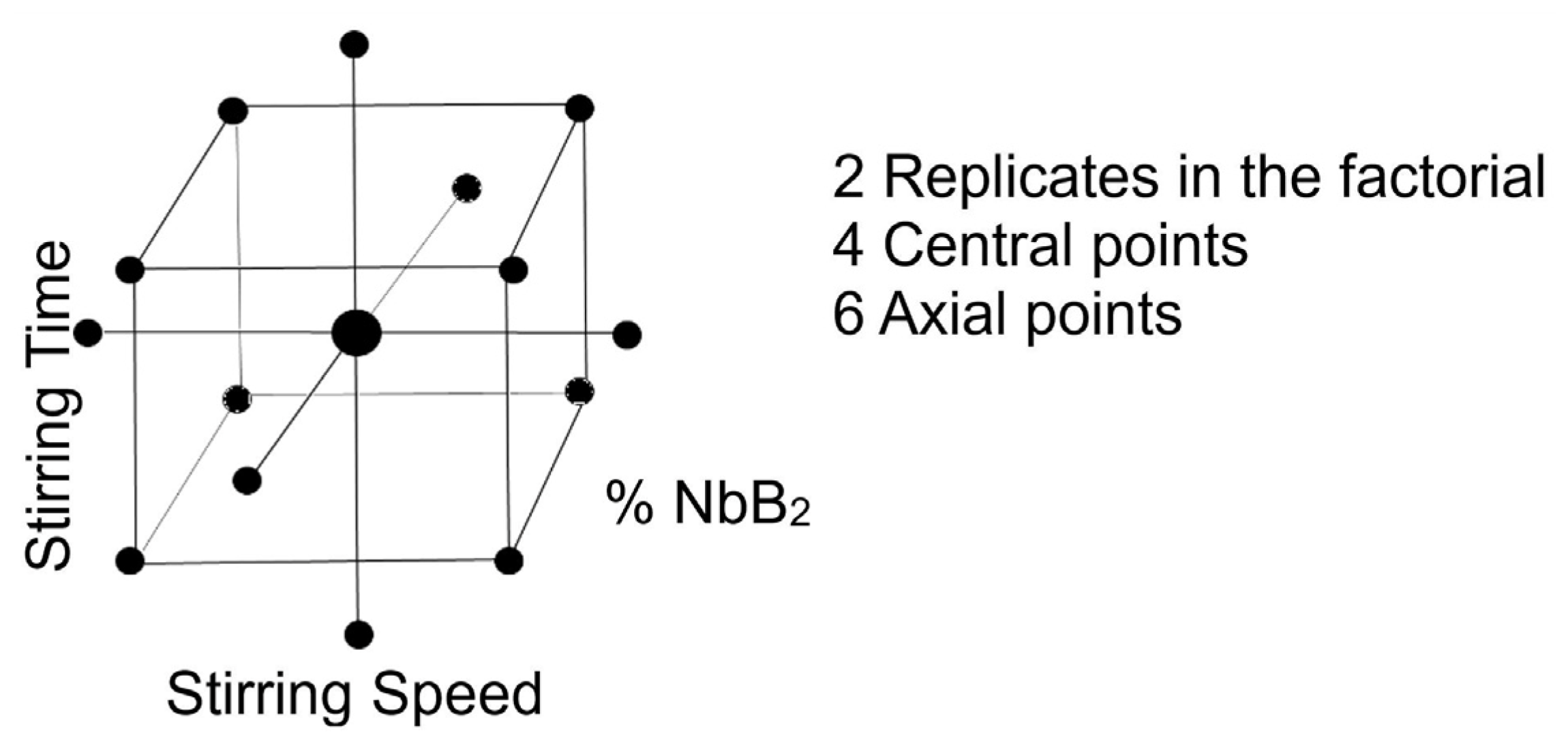
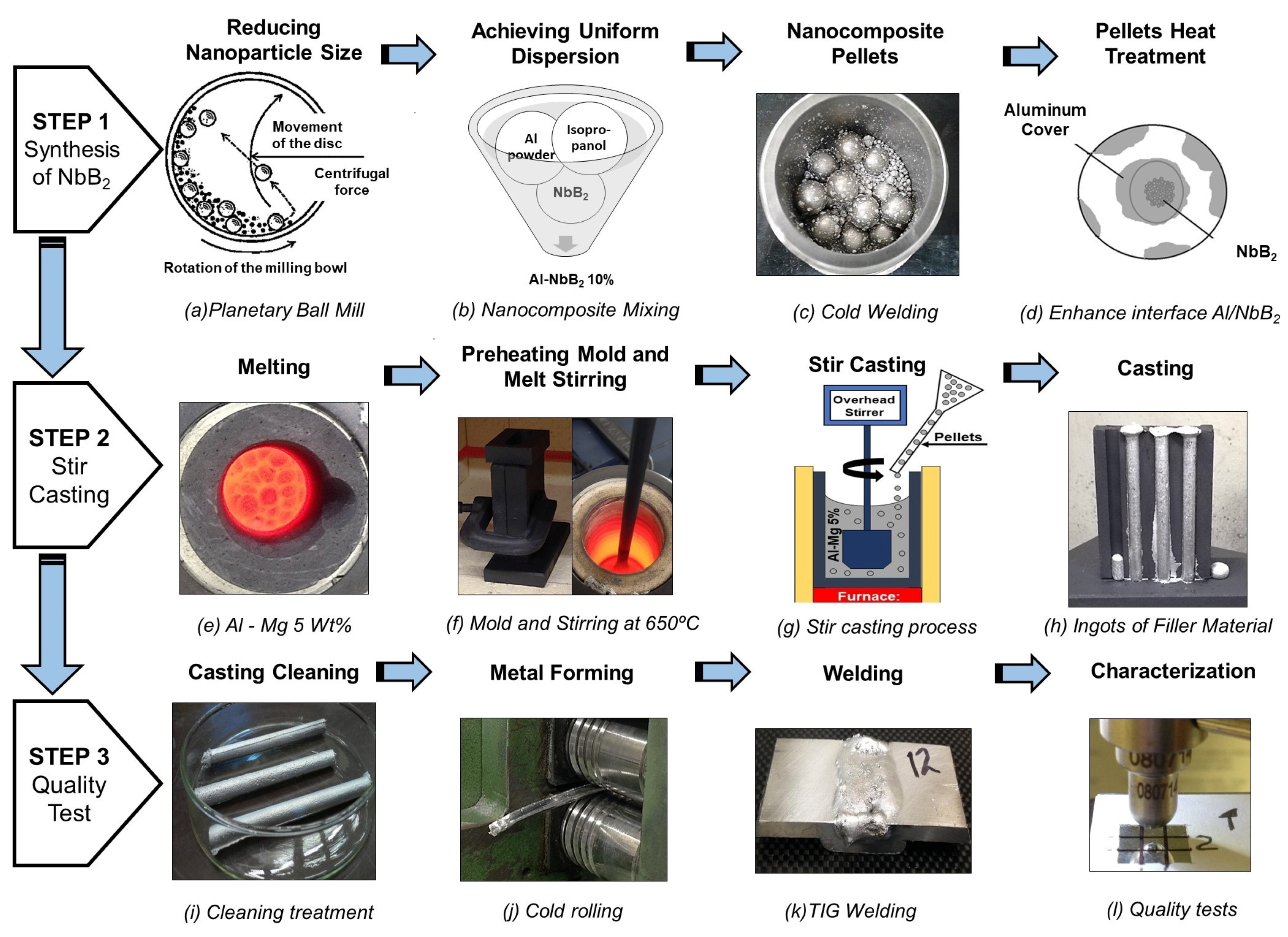
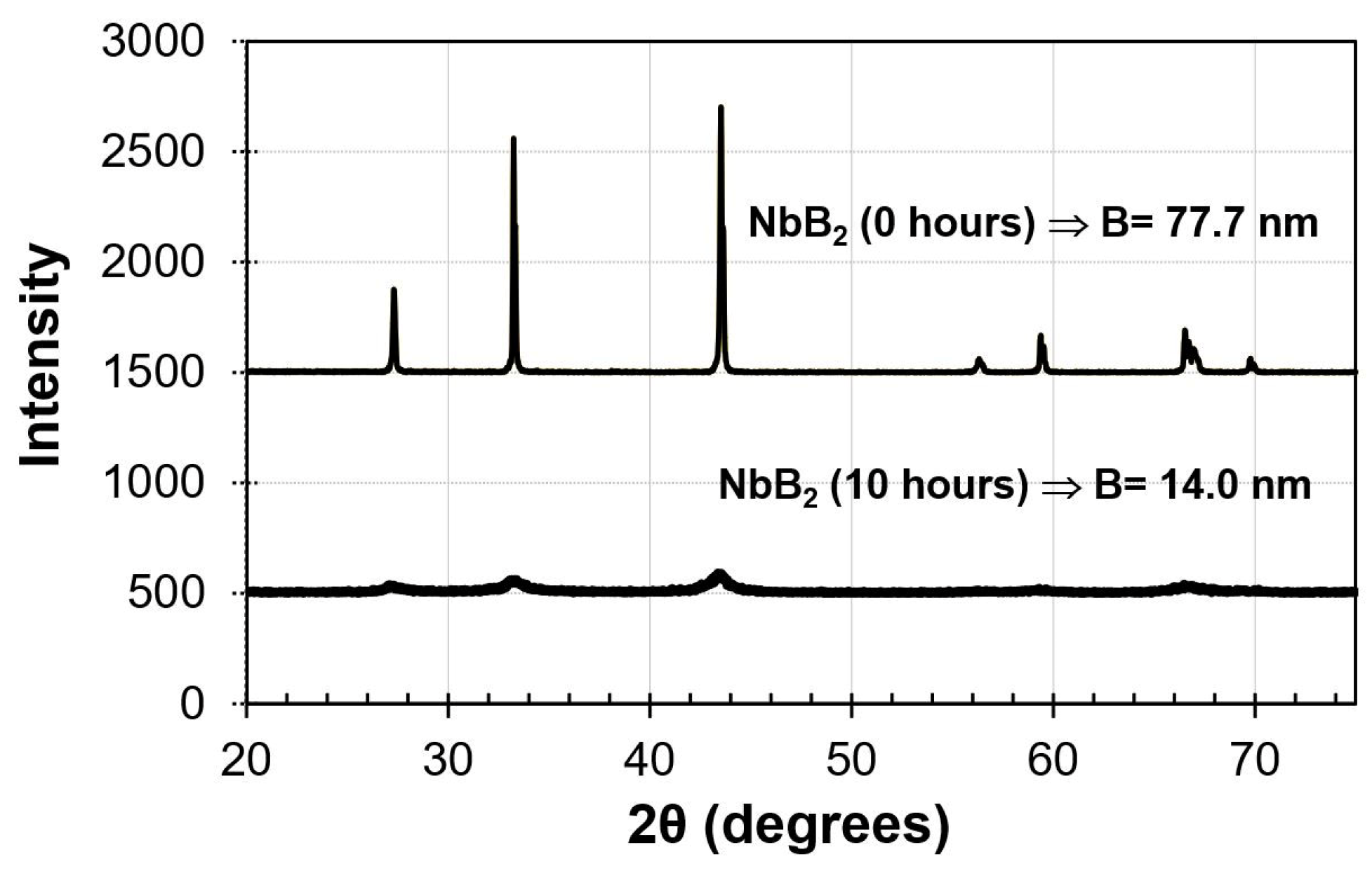
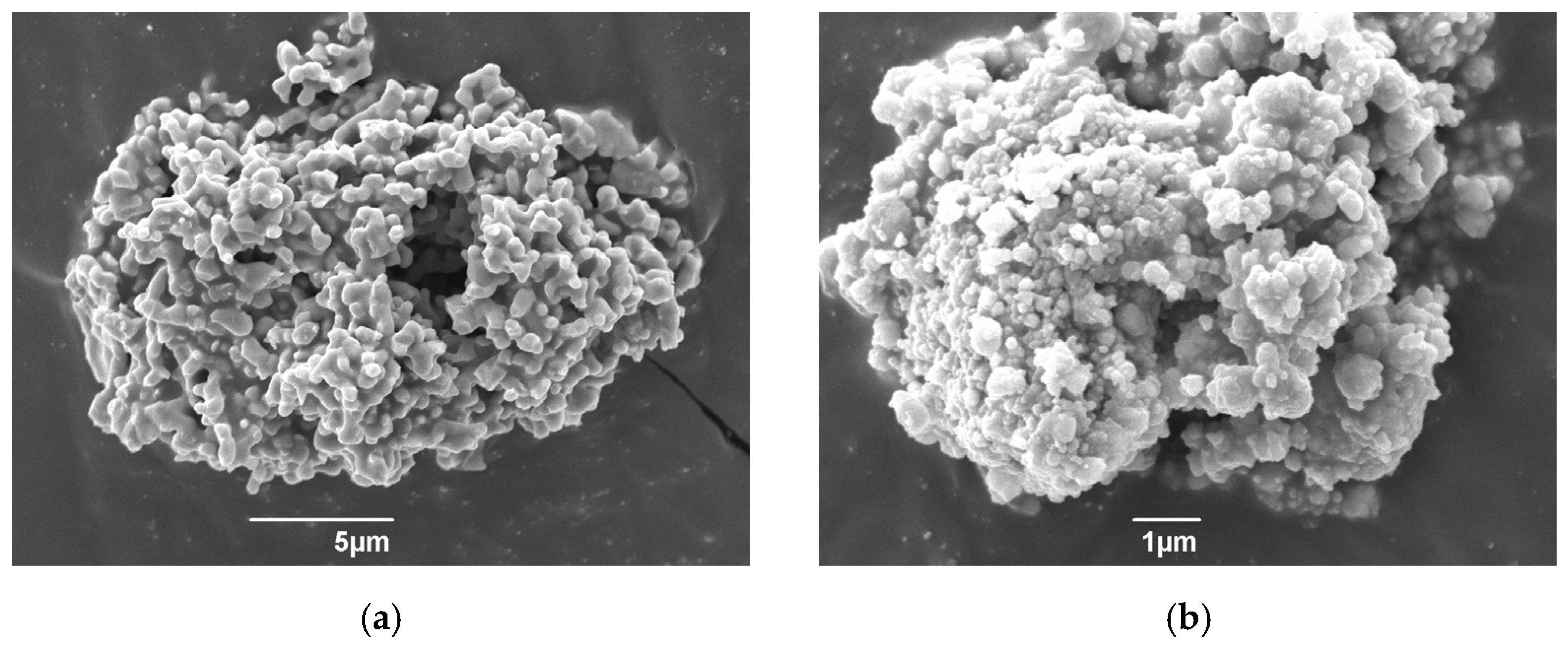
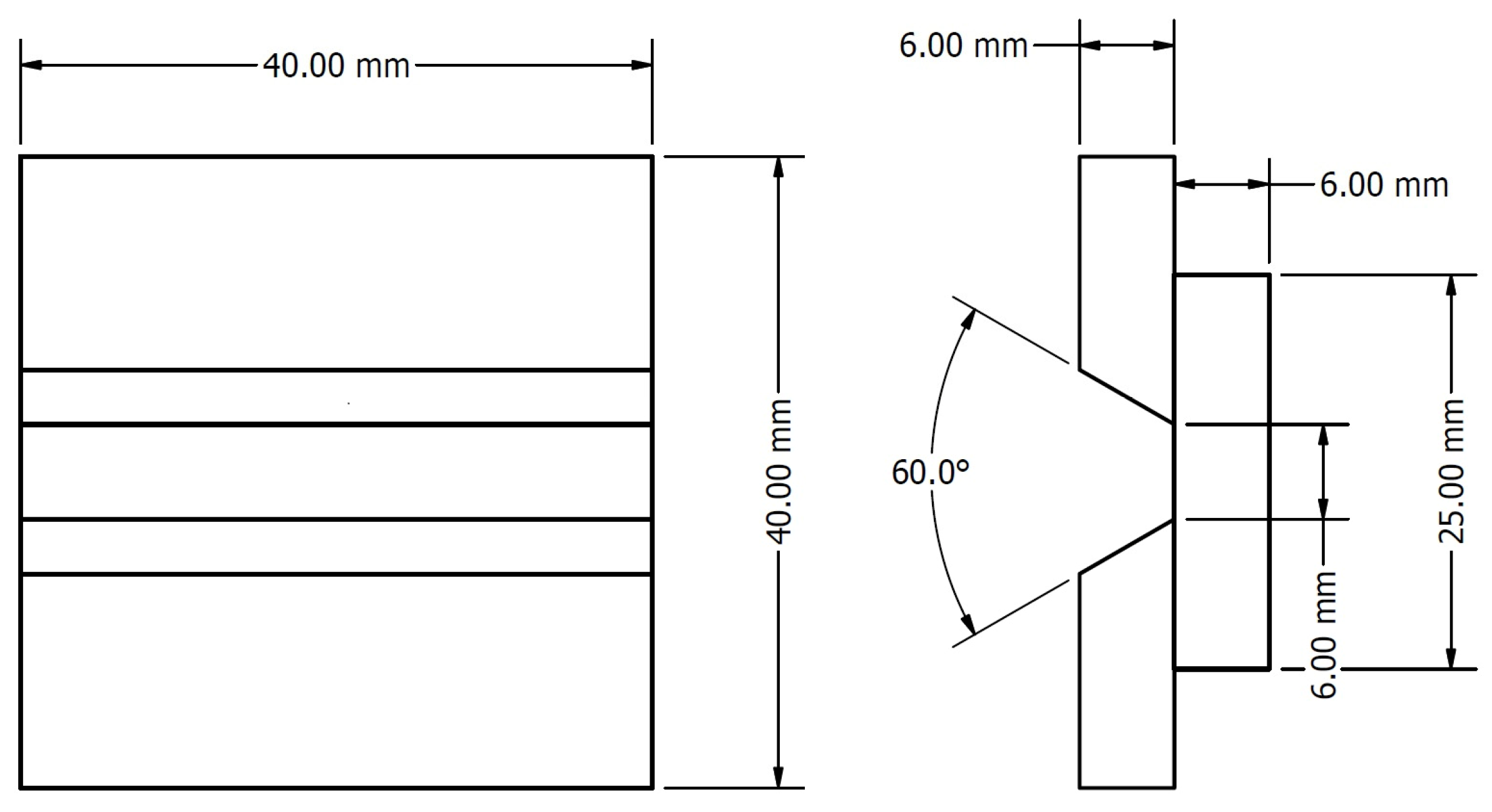


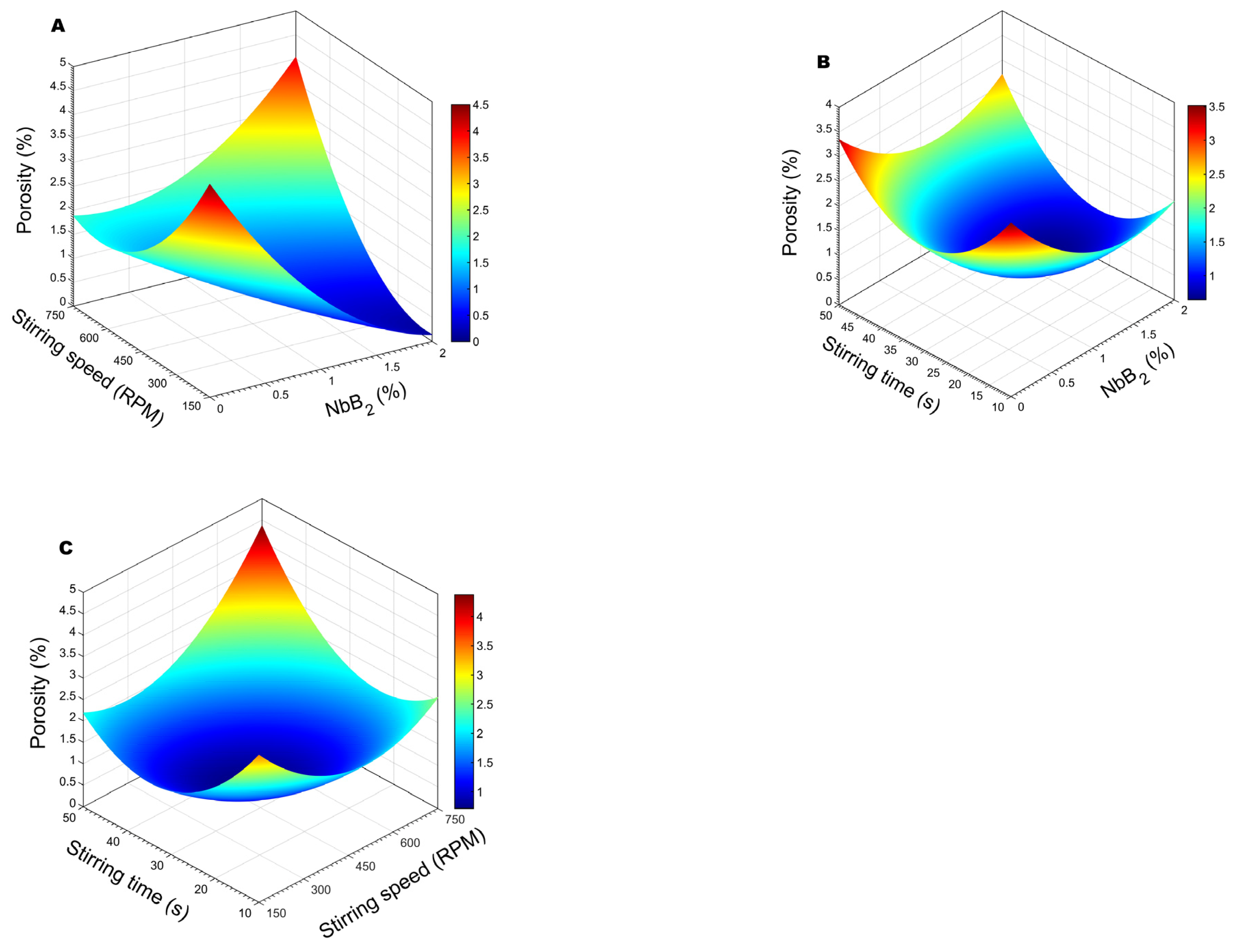
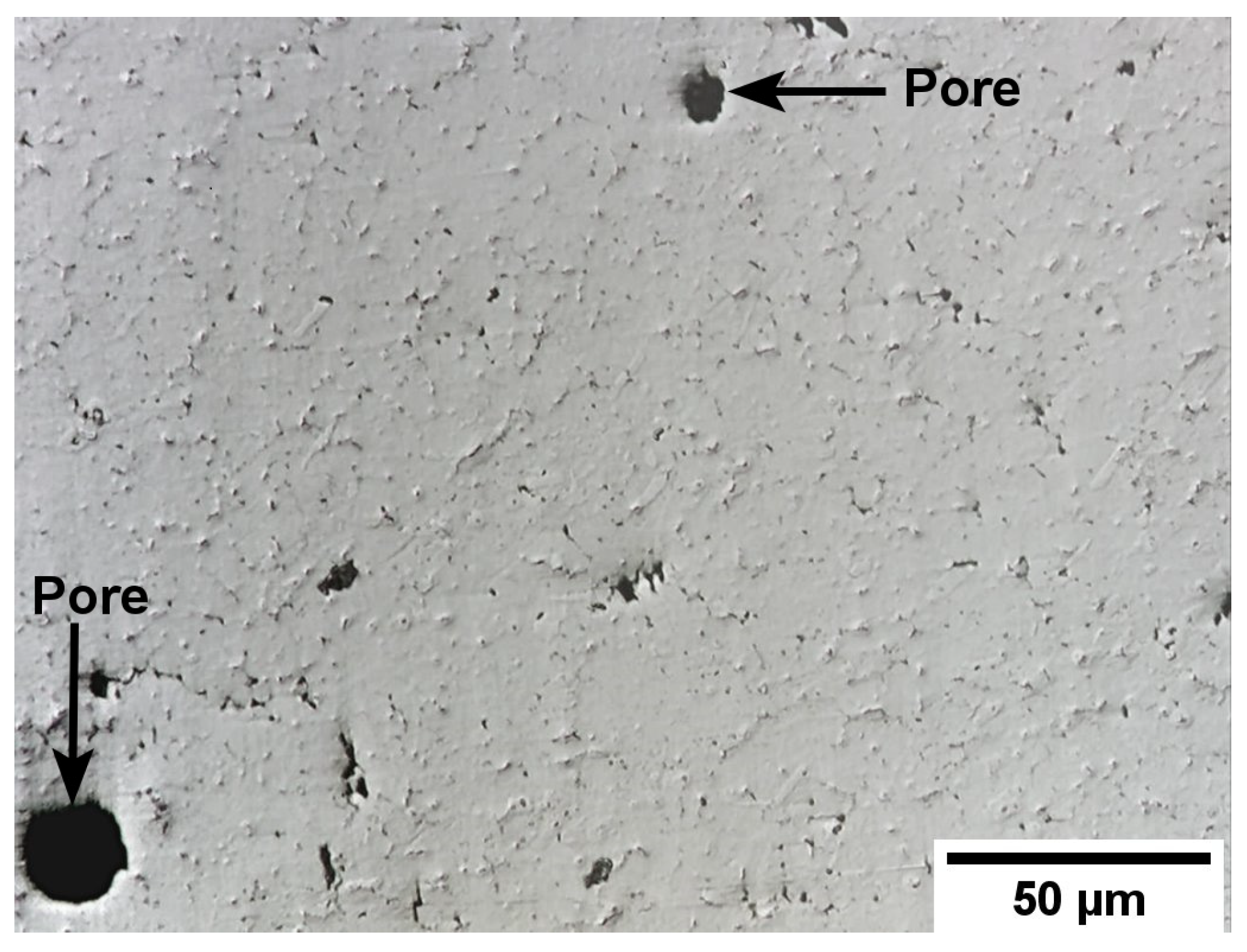
| Welding Parameters | Value | Units |
|---|---|---|
| Welding Current | 120–170 | A |
| Welding Speed | 100–120 | mm/min |
| Argon Flow Rate | 18 | cc/min |
| Wire Feed Speed | 6.1–7.6 | m/min |
| Torch angle | 60–80 | ° |
| Electrode diameter | 2.4 | mm |
| Filler rod diameter | 2.4 | mm |
| DF | Adj SS | Adj MS | F-Value | p-Value | |
|---|---|---|---|---|---|
| Model | 10 | 58.993 | 5.8993 | 18.71 | 0 |
| Blocks | 1 | 0.0051 | 0.0051 | 0.02 | 0.899 |
| Linear | 3 | 49.826 | 16.6086 | 52.67 | 0 |
| Percentage (%) | 1 | 37.142 | 37.1415 | 117.8 | 0 |
| Speed (rpm) | 1 | 6.4812 | 6.4812 | 20.56 | 0 |
| Time (s) | 1 | 6.2031 | 6.2031 | 19.67 | 0 |
| Square of factors | 3 | 7.98 | 2.66 | 8.44 | 0 |
| Percentage (%) × Percentage (rpm) | 1 | 0.1219 | 0.1219 | 0.39 | 0.535 |
| Speed (rpm) × Speed (rpm) | 1 | 3.6803 | 3.6803 | 11.67 | 0.001 |
| Time (s) × Time (s) | 1 | 0.7939 | 0.7939 | 2.52 | 0.115 |
| 2-Way Interaction | 3 | 1.1158 | 0.3719 | 1.18 | 0.321 |
| Percentage (%) × Speed (rpm) | 1 | 0.0228 | 0.0228 | 0.07 | 0.788 |
| Percentage (%) × Time (s) | 1 | 0.3162 | 0.3162 | 1 | 0.319 |
| Speed (rpm) × Time (s) | 1 | 0.7769 | 0.7769 | 2.46 | 0.119 |
| Error | 119 | 37.521 | 0.3153 | ||
| Lack-of-Fit | 4 | 1.5529 | 0.3882 | 1.24 | 0.297 |
| Pure Error | 115 | 35.968 | 0.3128 | ||
| Total | 129 | 96.515 |
| DF | Adj SS | Adj MS | F-Value | p-Value | |
|---|---|---|---|---|---|
| Model | 10 | 53.025 | 5.3025 | 33.41 | 0 |
| Blocks | 1 | 8.3991 | 8.3991 | 52.93 | 0 |
| Linear | 3 | 12.5931 | 4.1977 | 26.45 | 0 |
| Percentage (%) | 1 | 8.6864 | 8.6864 | 54.74 | 0 |
| Speed (rpm) | 1 | 3.3546 | 3.3546 | 21.14 | 0 |
| Time (s) | 1 | 0.5521 | 0.5521 | 3.48 | 0.065 |
| Square of factors | 3 | 4.055 | 1.3517 | 8.52 | 0 |
| Percentage (%) × Percentage (rpm) | 1 | 0.491 | 0.491 | 3.09 | 0.081 |
| Speed (rpm) × Speed (rpm) | 1 | 1.6713 | 1.6713 | 10.53 | 0.002 |
| Time (s) × Time (s) | 1 | 3.6975 | 3.6975 | 23.3 | 0 |
| 2-Way Interaction | 3 | 16.1331 | 5.3777 | 33.89 | 0 |
| Percentage (%) × Speed (rpm) | 1 | 13.0154 | 13.0154 | 82.02 | 0 |
| Percentage (%) × Time (s) | 1 | 0.2423 | 0.2423 | 1.53 | 0.219 |
| Speed (rpm) × Time (s) | 1 | 2.8754 | 2.8754 | 18.12 | 0 |
| Error | 119 | 18.8845 | 0.1587 | ||
| Lack-of-Fit | 4 | 3.0355 | 0.7589 | 5.51 | 0 |
| Pure Error | 115 | 15.849 | 0.1378 | ||
| Total | 129 | 71.9095 |
| Response | Goal | Lower | Target | Upper | Weight | Importance |
|---|---|---|---|---|---|---|
| Porosity (%) | Target | 0.08 | 3.9 | 4.29 | 1 | 1 |
| Brinell Hardness (MPa) | Maximum | 490.1 | 663 | 1 | 1 |
Disclaimer/Publisher’s Note: The statements, opinions and data contained in all publications are solely those of the individual author(s) and contributor(s) and not of MDPI and/or the editor(s). MDPI and/or the editor(s) disclaim responsibility for any injury to people or property resulting from any ideas, methods, instructions or products referred to in the content. |
© 2024 by the authors. Licensee MDPI, Basel, Switzerland. This article is an open access article distributed under the terms and conditions of the Creative Commons Attribution (CC BY) license (https://creativecommons.org/licenses/by/4.0/).
Share and Cite
Calle-Hoyos, A.F.; Burgos-León, N.A.; Feliciano-Cruz, L.I.; Florián-Algarín, D.; Rivera, C.V.; De Jesús-Silva, J.D.; Suárez, O.M. Multi-Objective Optimization of Novel Aluminum Welding Fillers Reinforced with Niobium Diboride Nanoparticles. J. Compos. Sci. 2024, 8, 210. https://doi.org/10.3390/jcs8060210
Calle-Hoyos AF, Burgos-León NA, Feliciano-Cruz LI, Florián-Algarín D, Rivera CV, De Jesús-Silva JD, Suárez OM. Multi-Objective Optimization of Novel Aluminum Welding Fillers Reinforced with Niobium Diboride Nanoparticles. Journal of Composites Science. 2024; 8(6):210. https://doi.org/10.3390/jcs8060210
Chicago/Turabian StyleCalle-Hoyos, Andrés F., Norman A. Burgos-León, Luisa I. Feliciano-Cruz, David Florián-Algarín, Christian Vázquez Rivera, Jorge D. De Jesús-Silva, and Oscar Marcelo Suárez. 2024. "Multi-Objective Optimization of Novel Aluminum Welding Fillers Reinforced with Niobium Diboride Nanoparticles" Journal of Composites Science 8, no. 6: 210. https://doi.org/10.3390/jcs8060210
APA StyleCalle-Hoyos, A. F., Burgos-León, N. A., Feliciano-Cruz, L. I., Florián-Algarín, D., Rivera, C. V., De Jesús-Silva, J. D., & Suárez, O. M. (2024). Multi-Objective Optimization of Novel Aluminum Welding Fillers Reinforced with Niobium Diboride Nanoparticles. Journal of Composites Science, 8(6), 210. https://doi.org/10.3390/jcs8060210







